Molecular detection of EGFR exon20ins in NSCLC: Why, when and how?








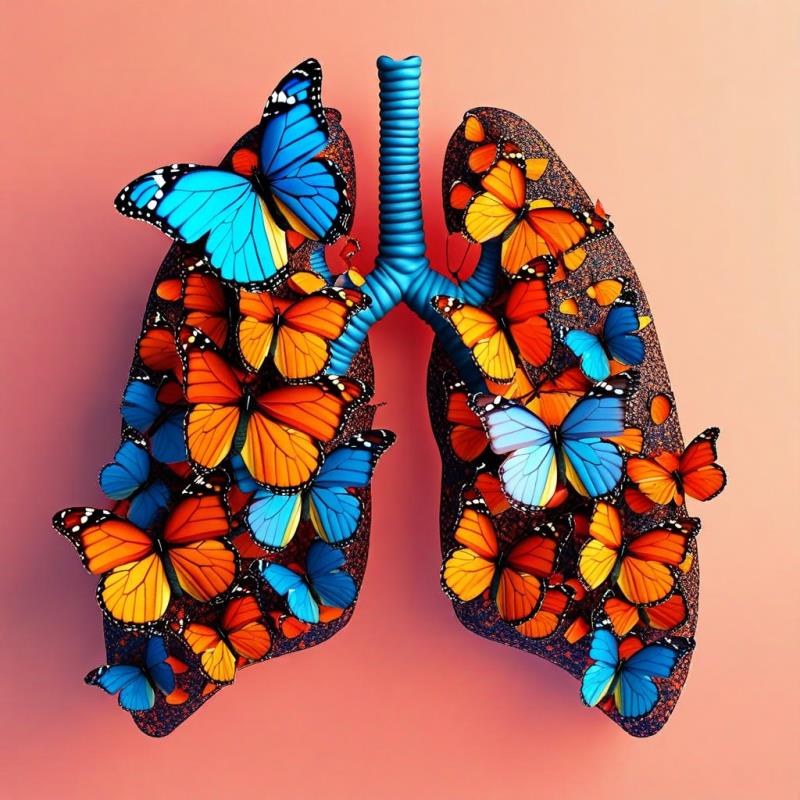
Genome-guided therapy has improved survival outcomes and reduced toxicities and complications from cytotoxic chemotherapy, thereby enhancing the quality of life of patients with non-small-cell lung cancer (NSCLC). At an industry-sponsored symposium, Dr Molly Li of the Department of Clinical Oncology, the Chinese University of Hong Kong, and Professor Yoon-La Choi of the Samsung Medical Center, Sungkyunkwan University School of Medicine, South Korea, focused on the clinical importance and challenges of detecting EGFR exon 20 insertions (exon20ins) in NSCLC patients and discussed the latest clinical evidence on EGFR exon20ins–targeted treatments.
EGFR exon20ins not rare in Asia
“Considerable ethnic and clinicopathological differences are observed in patients with NSCLC, with about half of Asian patients vs 5–15 percent of Caucasian patients harbouring an EGFR mutation,” said Li. (Figure 1) [Oncol Rep 2017;37:1347-1358]
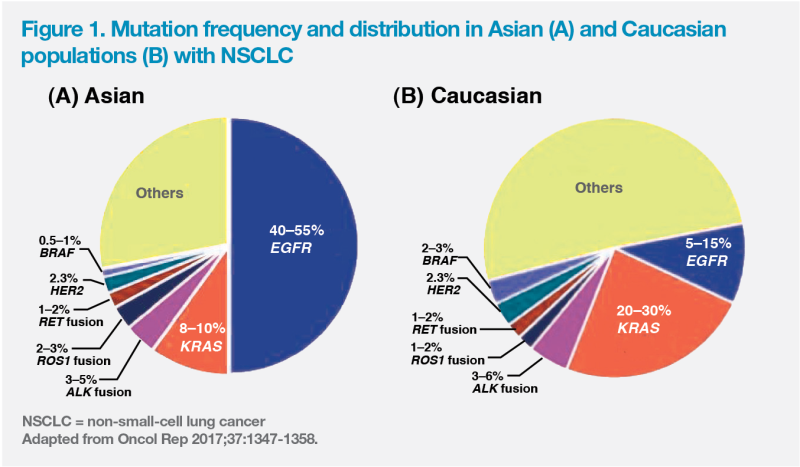
Among all EGFR mutations, exon20ins account for 9 percent of cases, representing the third most prevalent type of primary EGFR mutation in NSCLC after exon 19 deletions (46 percent) and L858R point mutation (38 percent). (Figure 2) [Mol Cancer Ther 2013;12:220-229]
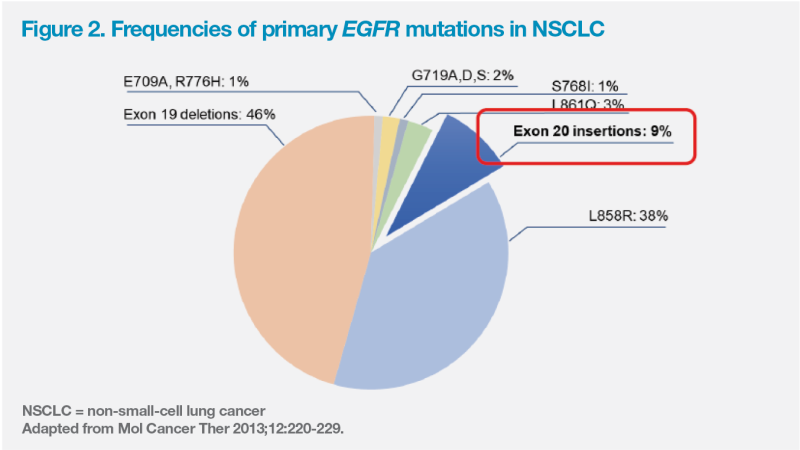
EGFR exon20ins mutations are molecularly heterogeneous and can occur as in-frame insertions and 3–21 base pair duplications (corresponding to 1–7 amino acids) between amino acids 762 and 774 of the EGFR protein. There are ≥122 different genomic variants identified, with approximately 90 percent of the insertions located in the adjacent loop after the α-C-helix of the intracellular domain of the EGFR protein, specifically between amino acids 766 and 775. Different insertion sites are associated with different disease phenotypes and patient characteristics, sensitivity to current therapies and, potentially, tumour immunogenicity. [Signal Transduct Target Ther 2019:4:5; Nat Rev Clin Oncol 2022;19:51-69]
“By calculation, EGFR exon20ins mutations account for 3–5 percent of all NSCLC cases in Asia. EGFR exon20ins mutations are more common than BRAF mutation, MET amplification and ROS1 rearrangement,” Li pointed out. [Front Genet 2019;10:1008]
“Notably, the numbering and notation for EGFR exon20ins have been variably and confusingly used in the literature. It is important to comply with the Human Genome Variation Society [HGVS] nomenclature 3’ rule and standardize the naming of mutations to avoid confusion. For instance, insertion of amino acids should be denoted as ‘duplication [dup]’ rather than an ‘insertion [ins]’ or ‘deletion-insertion [delins]’ and described at the 3’ end [carboxyl-terminal end] of the exon,” explained Choi. (Figure 3)
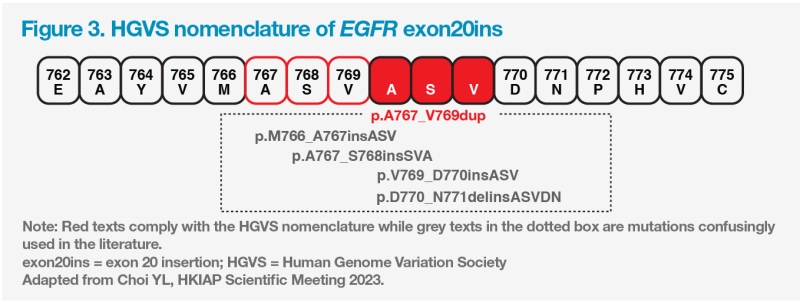
“The elevated frequency [of EGFR mutations (eg, exon20ins)] in Asian NSCLC patients underscores the critical importance of EGFR testing for tailored treatment approaches,” emphasized Choi.
“However, detection of and treatment development for EGFR exon20ins has lagged behind that for EGFR exon 19 deletions and L858R point mutation, as well as ALK, MET and BRAF alterations, because EGFR exon20ins are less common and traditionally resistant to tyrosine kinase inhibitors [TKIs]. Furthermore, polymerase chain reaction [PCR]–based diagnostics widely used in Asia may have limited ability to detect EGFR exon20ins,” Li commented.
“Accurate and timely detection of EGFR exon20ins is clinically important. A delay in [mutation] detection may delay effective treatment, as illustrated in the case of our patient who was treated with first-line immunotherapy. Inappropriate treatments can lead to additional financial burden and treatment-related toxicities,” Li said.
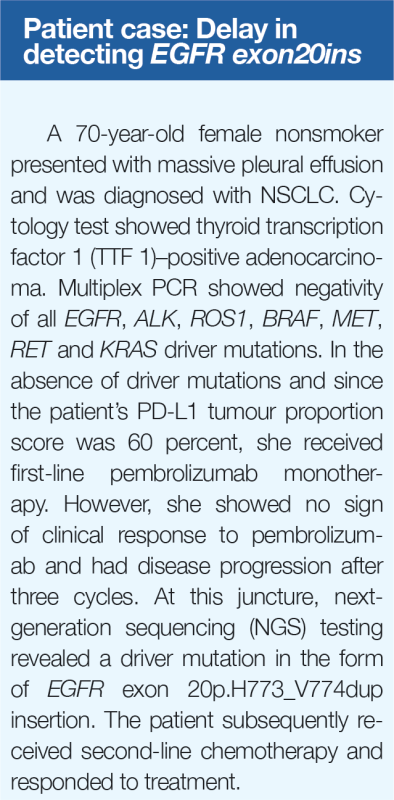
“Recent evidence suggests that there are no remarkable differences between the characteristics of patients with EGFR exon20ins vs other common EGFR mutations,” said Choi. [Ann Oncol 2022;33:S56_50P] “Hence, it is important to test NSCLC patients for exon20ins if they present with EGFR mutant characteristics and have a negative result for common EGFR mutations, or when adjuvant TKI therapy is considered for NSCLC at an early stage.”
Methodologies: Detection coverage and limitations
According to a summary of testing methods used by 264 laboratories from 45 countries, real-time PCR was the most frequently used testing strategy (51 percent), with cobas EGFR Mutation Test v2 being the most widely used test (27 percent). NGS represented the next most common testing strategy (27 percent). [BMC Cancer 2022;22:759]
An international cross-sectional medical chart review indicated that most EGFR test results (78 percent) were received in ≤14 days (median range, 7–14 days) from the order time. Notably, the median time from NSCLC diagnosis to EGFR test result was 18 days (median range, 10–22 days), and 37 percent of patients had already received a systemic treatment before the EGFR test result was available. [Lung Cancer 2023;175:47-56]
“Single-gene tests are more prevalent in Asian countries, such as South Korea and Taiwan, than gene-panel tests,” Choi pointed out. [Lung Cancer 2023;175:47-56] “Real-world genomic data from the FoundationInsights database [n=627] showed that single-gene tests, frequently performed with commercial real-time PCR kits, can detect only 48.6 percent of EGFR exon20ins variants, meaning that over half are missed.” (Figure 4) [Bauml JM, et al, WCLC 2020, abstract PF07.12]
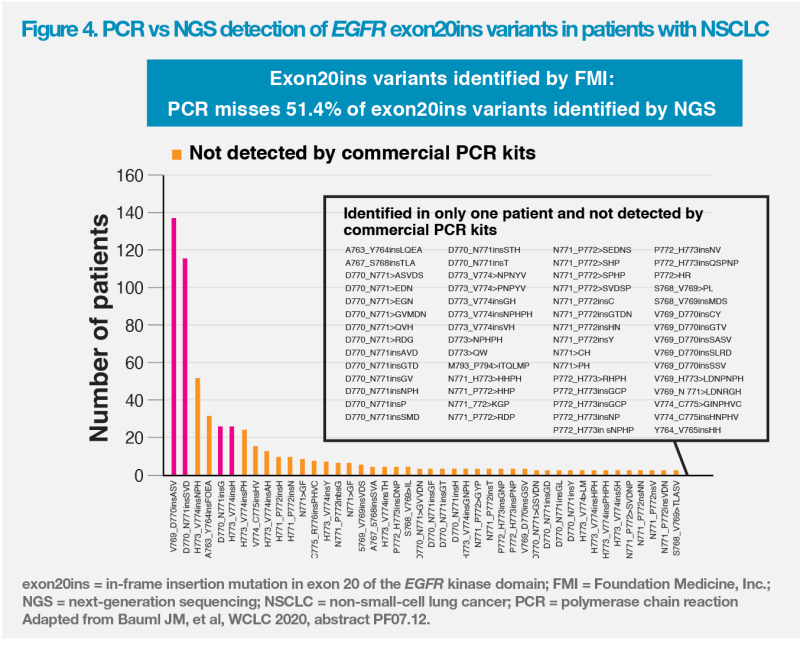
“NGS gene-panel tests, which are increasingly used, have broader coverage, but it is possible to have different levels of mutant variant coverage even on the same platform. Our data suggests that approximately 23 percent of EGFR exon20ins were still missed in amplicon-based Oncomine CDx Target test,” Choi remarked. [Choi YL, unpublished data, 2023]
Approved treatment for EGFR exon20ins–positive NSCLC
The EGFR-MET bispecific monoclonal antibody amivantamab is the first approved targeted therapy for advanced NSCLC patients with EGFR exon20ins mutations after failure of platinum-based therapy. [Rybrevant Hong Kong Prescribing Information]
The phase III, randomized PAPILLON trial (n=308) showed that after a median follow-up of 14.9 months, amivantamab plus chemotherapy significantly prolonged progression-free survival vs chemotherapy alone (11.4 vs 6.7 months; hazard ratio, 0.40; 95 percent confidence interval, 0.30–0.53; p<0.001) among systemic treatment–naïve patients with advanced EGFR exon20ins–positive NSCLC. (Figure 5) [N Engl J Med 2023;389:2039-2051]
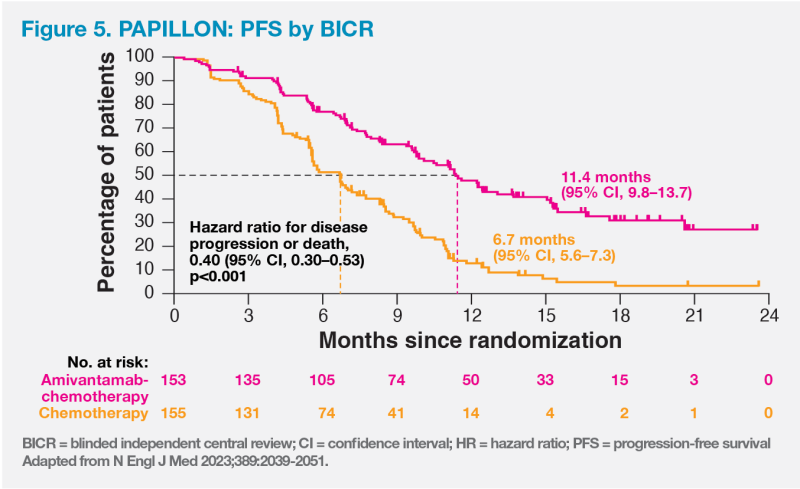
“In addition to the 60 percent reduction in relative risk of disease progression or death with amivantamab plus chemotherapy, 31 percent of amivantamab-treated patients remained progression-free at 18 months vs 3 percent of recipients of chemotherapy alone. Moreover, a complete or partial response was reported in 73 percent of patients in the amivantamab-chemotherapy group vs 47 percent of those in the chemotherapy group,” added Li. “Amivantamab plus chemotherapy is clearly a practice-changing regimen and will represent a good first-line treatment option for EGFR exon20ins–positive NSCLC in the near future.”
“Apart from amivantamab, multiple TKIs that target EGFR exon20ins are in development,” Li added.
Summary
EGFR exon20ins mutations are not rare among NSCLC patients in Asia. As targeted therapy is now available, early and accurate detection of EGFR exon20ins mutations is critical for appropriate treatment decisions and improving patient outcomes.